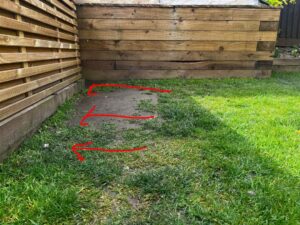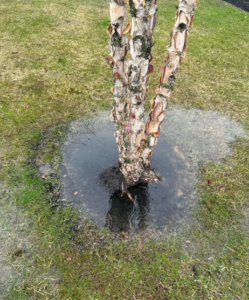Viewer’s question from Facebook. When these pavers were done I don’t think the installers put anything between them or seal the gaps between each block. What can I use to fill or seal the gaps? TIA for advice.

The Answer for filling gaps between your pavers
This fix is quite easy. Simply use a pressure washer to wash out the moss and weeds from in between the bricks. Make sure you clean out as much as you can, the more the better. Take extra caution not to move the bricks around too much, because this can cause them to become unlevel. After you have cleaned the joints, allow the surface area to completely dry, including under the bricks. I’d say give it 48 hours if it’s in direct sunlight. If not, give it 72 hours to dry. This would be a good time to watch the weather and plan accordingly. Once the area has dried, you then want to apply a good quality polymeric sand in between the joints. Make sure to select the right color for your pavers, so it matches and looks good. I highly recommend using Gator Maxx G2 Intelligent Polymeric Sand (no, I am not a sponsor of this product. Just one I have had great success within the field). There are polymeric sands that use lower-quality polymers, which will require you to redo it again sooner. Higher-quality polymers last longer and have a tighter hold. It’s important you know what you’re doing because there are mistakes that can be made along the way.
Common Reasons for Polymeric Sand Failures
- NOT reading the manufacturer’s directions and following them to a T.
- NOT waiting long enough for everything to dry. This includes in between the bricks and at the bottom of the bricks. If you apply the polymeric sand when it’s wet the sand will not cure correctly resulting in a bad cure.
- Sweeping the polymeric sand further than 10 feet in any direction. DO NOT DUMP IT IN ONE BIG PILE. Spread it over a larger area and sweep it in either direction no more than 10 feet at a time. These sands come with a lot of additives, polymers, and sand grains. The goal is to try and keep these additives, polymers, and sand grains together for a better cure.
- One common issue we frequently encounter is failing to properly compact the sand into the joints of the pavers. It is essential to utilize a gas compactor to effectively press the sand into the spaces between the bricks. Merely sweeping the sand over the surface is insufficient, as it may not reach the bottom of the joints, resulting in a weak bond. Inadequate compaction can also create opportunities for weeds to infiltrate the gaps. This is going to help with the durability and performance of the sand.
- Overfilling the joints. It is possible to overfill the joints. The sand should be filled 1/8 inch below the top of the paver. This is done to prevent friction and erosion of the sand. If the sand is too high, foot traffic can erode it and create unnecessary pressure on the sand, which is undesirable.
- Last, another common failure is not following the correct watering directions per the manufacturer’s requirements. Don’t go online and Google this question. You should carefully read your manufacturer’s requirements because there will be different watering requirements.






